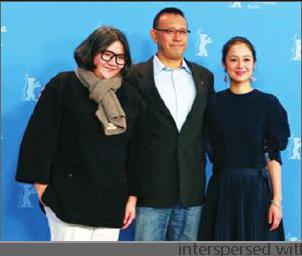A Grave Misfire?
2015-03-12ByEricDaly
By+Eric+Daly

It was hard to go anywhere in Beijing in December 2014 without being assailed by posters advertising Chinese auteur Jiang Wens latest movie Gone With the Bullets. I was drawn to the films beautiful promotional material showing Jiangs character with one of the films female leads adversarially juxtaposed against Ge yous character and another female character. I was also taken with the title, blending associations of a rip-roaring old-fashioned romantic epic, interspersed with frequent bouts of gunfire.
Advance word on the movie was good internationally, and the films opulent promotional campaign whetted appetites on the home front. It carried an enormous budget of 300 million yuan ($48.8 million). Jiangs previous movie Let the Bullets Fly (2010) had broken box office records for domestic releases in China. His body of work, including Devils on the Doorstep(2000) and The Sun Also Rises (2007), is held in high esteem worldwide. Jiang appeared to be one of those rare directors who could straddle the realms of commercial success and artistic excellence without having to compromise on either. All in all, Gone With the Bullets looked like a surefire success.
Fast forward to mid-January, and a different story emerged. Although it performed well on its opening weekend, Gone With the Bullets had failed to match up to the stellar expectations preceding it, not just in terms of box office receipts. International press reports stated the response from both professional critics and audiences in China had been vicious. Reading through some of the feedback second hand, it struck me that some of the comments were curiously touched by hurt or betrayal, as if filmgoers felt hoodwinked into seeing a film far removed from what was advertised. Audience members did not merely dislike the film; they were horrified by it. Naturally, this only piqued my interest further.
An experimental approach
Unfortunately, for review purposes, an Englishsubbed version of the movie was unavailable. Given the criticism of the film for its experimental indulgence, I therefore reasoned that it might be appropriate in this instance to attempt the correspondingly gonzo exercise of reviewing the movie with no subtitles. Doing so, I thought, would enable me to see how intuitively comprehensible the films narrative line was. Besides, if reviews by some Chinese netizens were anything to go by, even native proficiency in Mandarin provided no especial advantage in understanding the films plot.
Going in, I purposefully avoided further reading of reviews or synopses, wishing to ensure that my response to Chinas “Most Disappointing Film of 2014” would be as untouched by preconception as possible. I knew only a few details: that the movie was a spiritual sequel to Let the Bullets Fly, and that like that movie, it was set during the warlord era in the early 20th century but switched location from Sichuan Province to Shanghai.
In preparation, I also reasoned I could watch Jiangs previous film. I loved it: an intensely likeable and lively Oriental Western, with a wonderfully hammy performance by Hong Kong actor Chow yun-fat as the movies villain set against the straight man foil of Jiangs bandit king. The movies dialogue was superb and the comic timing, delivery and facial expressions of Ge, whom I now believe to be an actor from the cinemas silent era somehow stranded in the present, made me laugh out loud.
If I had one gripe, it was that some of the characters whose deaths were supposed to resonate in the finale were not sufficiently developed, robbing the film of some of its emotional and thematic impact. At 132 minutes, the film also somewhat outstayed its welcome in terms of running time, though its irrepressible charm and energy just about sustained the viewers interest.
False advertising
I went into my first viewing of Jiangs new foray into the playground of history with some trepidation. The movies opening reminded me of that of American director Quentin Tarantinos Inglourious Basterds (2009), in that it consists of a largely unbroken monologue powerfully delivered by actor Wen Zhang, with the camera gradually zooming out to reveal the rear of the shoulder and the head of the other participant in the conversation, a powerful framing device as the other partys facial expressions remain unseen to the viewer and have to be inferred from the actor facing the camera, maximizing tension. The presence of tuxedos with poppies pinned to lapels, cigar smoking and the stroking of a white rabbit in obvious homage to The Godfather conformed to my expectation that this was to be a gangster film.
This scene segued into one of the films high points: a sensational Busby Berkeley-style Jazz Age-themed cabaret show during an international beauty pageant. It was a scene of such visual vibrancy and crackling choreography that it almost put films such as Moulin Rouge and Chicago in the shade. All of the visual and auditory elements, from costume to set design to music, were superb. The movie also shared its spiritual predecessors flair for anachronism, as some of the music used in the set piece was composed after the films time. Unlike Let the Bullets Fly, there was an abundance of non-Chinese extras, fitting given that the films opening is set in Shanghais French Concession. As good as this sequence was, it ran a little long and I wondered when the filmmakers were going to get into the real meat of the story.
The film then documents the love affair between Jiangs protagonist and the Chinese winner of the pageant. Without giving too much away, after a night of dream-like opium-fuelled hedonism, it comes to an untimely end, and the rest of the film deals with the consequences. This serves as the plots inciting incident, and it comes after a lot of set-up. At this point, it started to dawn upon me that this was not a conventional gangster movie but an epic drama that satirizes the nouveau riche. Despite its title, one has to wait until around the films half-hour mark before a single shot is fired, then wait again until a madcap chase scene preceding the finale. This, I surmised, may have been what drew critics and audiences ire in China, as they may have thought the films marketing disingenuous.
Bullet points
At this point, the film completely lost me, which prompted me to go back and engage in a light research on the 1920 yan Ruisheng case on which the film is based before viewing it a second time. Armed with a detailed synopsis from the website of Film Business Asia, the movie made a lot more sense on second viewing. Still, it didnt quite cohere, and I suspect subtitles would not have helped. Jiang employs a number of increasingly sophisticated and experimental storytelling techniques: newsreel footage, theatrical and animated enactments of the inciting incident, and a film within a film. The film is also highly artistically literate, with a final scene involving a giant windmill plucked straight from the pages of Don Quixote and delightful use of music by Italian composer Giacomo Puccini.
Though impressive, it cannot make up for the lack of clear narrative. There is no clear-cut antagonist or sense of conflict, and the zany supporting cast, though superbly played, has little agency in driving the plot forward. Events merely seem to happen, and it is arguable that Jiang may have focused on art to the expense of storytelling craft.
There is a lot of the director in this movie, both literally and figuratively, and I wonder if this may have been part of the problem. The story seems overstuffed and though it is only minutes longer than Let the Bullets Fly, it seems far longer than that movie. I suspect Jiang may have thought of this project as his Great Gatsby and became so embroiled in the creative process that he forgot to come up for air. This might have been further exacerbated by the eight screenwriters reportedly working on the script, as the films busyness smacks of too many cooks spoiling the broth. On the whole, watching Gone With the Bullets is akin to viewing an incredibly beautiful cathedral slowly collapse owing to integral flaws in its design.
The fact, however, that the film does not quite work on the narrative level does not take away from the sweep of its ambition, the grandeur of its spectacle or the technical virtuosity involved. I rather admire Jiangs bloody-mindedness and refusal to compromise for his artistic vision. Its rare in these days of increasingly homogenous, demographically targeted massmarket blockbusters. It is also splendid to see cutting-edge camera technology so expertly used on something other than an action film. Gone With the Bullets is many things: bewildering, frustrating and occasionally even infuriating. It is, however, never boring. Although I will have to wait for the subtitled version to pronounce the final verdict, if the film is indeed a failure, then it is one touched by genius.
